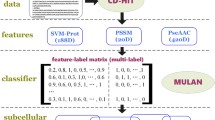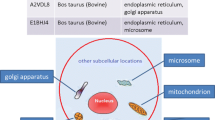Abstract
Protein’s subcellular location, which indicates where a protein resides in a cell, is an important characteristic of protein. Correctly assigning proteins to their subcellular locations would be of great help to the prediction of proteins’ function, genome annotation, and drug design. Yet, in spite of great technical advance in the past decades, it is still time-consuming and laborious to experimentally determine protein subcellular locations on a high throughput scale. Hence, four integrated-algorithm methods were developed to fulfill such high throughput prediction in this article. Two data sets taken from the literature (Chou and Elrod, Protein Eng 12:107–118, 1999) were used as training set and test set, which consisted of 2,391 and 2,598 proteins, respectively. Amino acid composition was applied to represent the protein sequences. The jackknife cross-validation was used to test the training set. The final best integrated-algorithm predictor was constructed by integrating 10 algorithms in Weka (a software tool for tackling data mining tasks, http://www.cs.waikato.ac.nz/ml/weka/) based on an mRMR (Minimum Redundancy Maximum Relevance, http://research.janelia.org/peng/proj/mRMR/) method. It can achieve correct rate of 77.83 and 80.56% for the training set and test set, respectively, which is better than all of the 60 algorithms collected in Weka. This predicting software is available upon request.
Similar content being viewed by others
References
Chou KC, Elrod DW (1999) Protein subcellular location prediction. Protein Eng 12: 107–118
Eisenhaber F, Bork P (1998) Wanted: subcellular localization of proteins based on sequence. Trends Cell Biol 8: 169–170
Hua S, Sun Z (2001) Support vector machine approach for protein subcellular localization prediction. Bioinformatics 17: 721–728
Yuan Z (1999) Prediction of protein subcellular locations using Markov chain models. FEBS Lett 451: 23–26
Reinhardt A, Hubbard T (1998) Using neural networks for prediction of the subcellular location of proteins. Nucleic Acids Res 26: 2230–2236
Frank E, Witten IH (2005) Data mining: practical machine learning tools and techniques. Morgan Kaufmann, San Francisco
Gewehr JE, Szugat M, Zimmer R (2007) BioWeka—extending the Weka framework for bioinformatics. Bioinformatics 23: 651–653
Gonzalez-Diaz H, Aguero-Chapin G, Varona J, Molina R, Delogu G, Santana L, Uriarte E, Podda G (2007) 2D-RNA-coupling numbers: a new computational chemistry approach to link secondary structure topology with biological function. J Comput Chem 28: 1049–1056
Munteanu CR, Gonzalez-Diaz H, Magalhaes AL (2008) Enzymes/ non-enzymes classification model complexity based on composition, sequence, 3D and topological indices. J Theor Biol 254: 476–482
Peng HC, Long FH, Ding C (2005) Feature selection based on mutual information: criteria of max-dependency, max-relevance, and min-redundancy. IEEE Trans Pattern Analysis Mach Intell 27: 1226–1238
Cai YD, Chou KC (2006) Predicting membrane protein type by functional domain composition and pseudo-amino acid composition. J Theor Biol 238: 395–400
Won HH, Kim MJ, Kim S, Kim JW (2008) EnsemPro: an ensemble approach to predicting transcription start sites in human genomic DNA sequences. Genomics 91: 259–266
Cedano J, Aloy P, Perez-Pons JA, Querol E (1997) Relation between amino acid composition and cellular location of proteins. J Mol Biol 266: 594–600
Author information
Authors and Affiliations
Corresponding author
Additional information
Yu-Dong Cai and Lin Lu are contribute equally to this work.
Electronic Supplementary Material
The Below is the Electronic Supplementary Material.
Rights and permissions
About this article
Cite this article
Cai, YD., Lu, L., Chen, L. et al. Predicting subcellular location of proteins using integrated-algorithm method. Mol Divers 14, 551–558 (2010). https://doi.org/10.1007/s11030-009-9182-4
Received:
Accepted:
Published:
Issue Date:
DOI: https://doi.org/10.1007/s11030-009-9182-4




